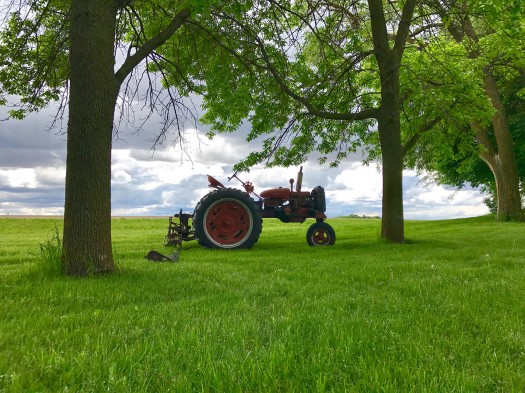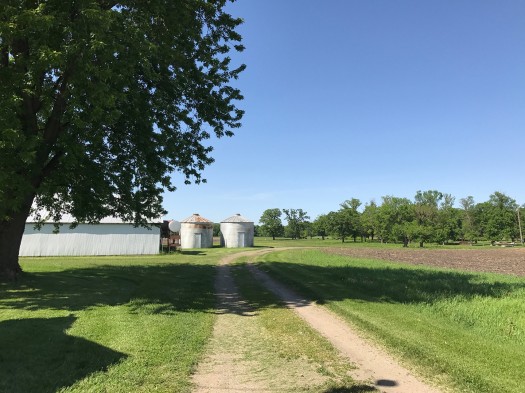A Placemaking Journal
Land Use: Preserving the rural landscape with agrarian urbanism
 As the harvest starts to come in here in Manitoba and conversations with my farming friends point to a good yield, I’ve been thinking about how to preserve these lands. Rural communities are often the ones with the greatest constraints, especially when it comes to finances. Without federal support, holistic zoning reform in agrarian places is rare. This, coupled with perverse incentives in lending practices, leaves some of the most valuable assets in North America – highly productive farm lands – with the least resources available for land use reform to protect them.
As the harvest starts to come in here in Manitoba and conversations with my farming friends point to a good yield, I’ve been thinking about how to preserve these lands. Rural communities are often the ones with the greatest constraints, especially when it comes to finances. Without federal support, holistic zoning reform in agrarian places is rare. This, coupled with perverse incentives in lending practices, leaves some of the most valuable assets in North America – highly productive farm lands – with the least resources available for land use reform to protect them.
These rural lands are incredibly beautiful landscapes – agriculturally, economically, and culturally. However, most parts of the country have reduced their zoning law so that so-called agriculture zones are frequently zoned for 5 acre minimums. These small acreages produce little more than land-consuming hobby farms, with the exception of a few dense crops like pecans and coffee. Otherwise, there is little that can be profitably produced in traditional farming methods on this size of lot.

Rich Valley, Minnesota. Image: Creative Commons Sharealike License with Attribution to Susan Henderson at www.placemakers.com
Talking with my partner, Susan Henderson, provides some food for thought as she prepares for an inaugural FBCI Forum session dealing with form-based codes in the rural context. She points out that for some counties in Minnesota and other places with historic homestead structure, agriculture is zoned at a 40-acre minimum. Larger farms also have the potential to subdivide and cluster effectively, since the 40-acre minimum applies to the gross acreage, not the subdivided parcel. Take, for instance, a 400-acre farm could develop ten ¼-acre home sites, maintaining most of the land as working ag.
In addition to land use that perversely incentivizes the destruction of rural lands with 5-acre lots, the financial system further incentivizes rural subdivisions gobbling up farmland at a frightening rate. Farmers need the opportunity to finance production based on their ability to subdivide. Lenders mortgage the land based on their underlying zoning capacity, putting the wrong value on the land by implying that the highest and best use is subdivision. This is a very real problem, in order to both preserve our agricultural heritage as well as ensure food security.

Rich Valley, Minnesota. Image: Creative Commons Sharealike License with attribution to Susan Henderson at www.placemakers.com
Traditionally, hamlets and villages support the surrounding farming community with the compact development that developed organically adjacent to a school, post office, or general store. This micro-scale development reduced trip generation and preserved views. Taking the train across France is so delightful due to this congregation of development, leaving the fields for food production. Scarcity of land has forced them to be excellent stewards of maintaining it.
From the sustainability perspective, we do not like to talk about greenfields so much, but they make complete sense when talking about community development in support of farming communities.

Rich Valley, Minnesota. Image: Creative Commons Sharealike License with attribution to Susan Henderson at www.placemakers.com
Susan Henderson tells me, “We are very aware of the importance of the problem, but there is no clear solution set. Each place achieving these goals is doing so at their own pace and pattern. I’m looking forward to the FBCI Forum, where practitioners, professionals, and administrators with be gathering in Washington, DC in October to work together and learn from each other. Planning directors and city managers as well as private planners and code writers will be talking about their own experiences with form-based codes. Hopefully together we will craft some new solutions and ideas to this issue, and others like it.”
The forum is put on by the Form Based Codes Institute in partnership with Smart Growth America, both of whom have had a big voice in the advancement of form-based codes over the last few decades. They have broken trails in research and education for land use ordinances that can promote walkable, mixed-use urban places. FBCI’s library of codes for reference which is a great repository of inspiring form-based codes.

Hamlet illustration. Image credit: Doña Ana County, New Mexico; urban designer: DPZ
I talked with one of the organizers of the forum, Christopher Zimmerman, Smart Growth America’s Vice President for Economic Development, and Director of the Governors’ Institute on Community Design. He reiterates, “Form-based codes are an essential tool to deal with getting design right. Walkable design is out of step with the majority of land use regulation. This makes it difficult – and sometimes impossible – to build Smart Growth. This also accounts for gross overconsumption of land, destroying ag lands, parks, and wilderness at an alarming rate. Frankly the real estate market wants walkable design. But right now, we are regulating away from the marketplace instead of toward it.”
Marta Goldsmith, Executive Director of FBCI, tells me, “We have seen a growing interest in form-based codes in recent years. The FBCI Forum is the first event of this format, where land use professionals and decision-makers from across the country come together to discuss trends, innovations, and best practices. More than 25 experts and practitioners are confirmed to speak on topics like maintaining inclusiveness, retro-fitting the suburbs, historic preservation and downtown revitalization. Attendees will work through how form-based codes influence these dynamics.”
One of the things that sounds interesting at the forum is the tour of Columbia Pike, in Arlington, Virginia, to analyze a well-tested form-based code in action. Adopted in 2003, with plenty of development complete and ongoing, the area is packed with lessons. The forum will convene a panel with locals along with the Dover Kohl consultant team. While form-based codes are often blamed for gentrification, an affordable housing developer will help us understand how they are keeping the workforce dwelling in this very livable place. A citizen who was Planning Commission Chair will talk about the challenges and solutions in finding common ground between local residents and the business community.
While I haven’t quite worked out my work schedule for October, the forum is definitely high on my list. For all of you doing the heavy lifting of changing the rules to increase livability, keep up the great work. And make sure to keep us up to date on your successes via the Codes Study.
If PlaceShakers is our soapbox, our Facebook page is where we step down, grab a drink and enjoy a little conversation. Looking for a heads-up on the latest community-building news and perspective from around the web? Click through and “Like” us and we’ll keep you in the loop.


